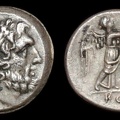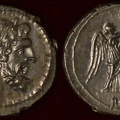
Roman Republic AR Victoriatus(3.10g). Anonymous, ca. 211 B.C., military mint in Spain. Laureate head of Jupiter right. Border of dots / Victory standing right, crowning trophy with wreath. Below, ROMA incuse on tablet. Line border. Crawford 96/1
This victoriatus, unlike all my other victoriati, has a fully incuse legend on the reverse, a feature unique to these victoriati but which also appears on a tiny number of early denarii and on the earliest quadrigati. Surprisingly, the find evidence does not suggest that these victoriati were minted alongside either the incuse-legend quadrigati or the denarii, so while the feature is shared by these various coins, it seems to have simply been a stylistic choice by some of the engravers, perhaps in imitation of the early quadrigati.
So where do these coins fit into the context of the Second Punic War and what makes them so interesting outside of the design variation? First, every single example with a known or reported findspot was found in Spain and when new examples do come to market they almost always come through Spanish dealers or auction houses, so we can be pretty confident that these were minted in Spain. Second, while there is little hoard evidence for these types(owing to their overall rarity), the high weight standard and the experimental design feature of the incuse legend point to an origin in the earliest period of the denarius coinage circa 212 or 211 B.C. before the weight standard was lowered and when many coinage experiments such as the half-victoriatus and incuse legend denarii seem to have been going on.
If these coins were minted at this time period in Spain they were almost certainly struck at a military camp under the control of one of the Cornelii Scipiones, either Publius Cornelius Scipio and his brother Gnaeus Cornelius Scipio Calvus, both of whom were defeated at the battle of the Upper Baetis in 211 B.C., or Publius's son, also a Publius but better known to history by the name Scipio Africanus. The younger Publius was elected proconsul and sent to Spain at the head of an army in the wake of his father's death and would go on to conquer Hispania and end Carthaginian rule in the area in 206 B.C. before being unanimously elected Consul in 205 B.C.. He then took his forces southward, first to Sicily and then to Africa where he defeated Hannibal at the battle of Zama in 202 B.C., earning himself the agnomen Africanus.


0 comments
Add a comment